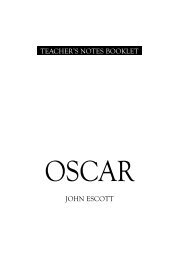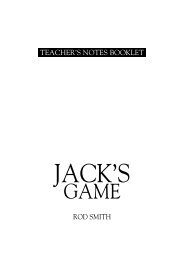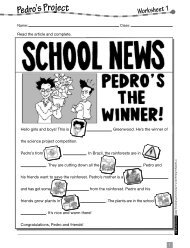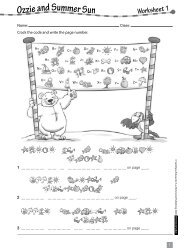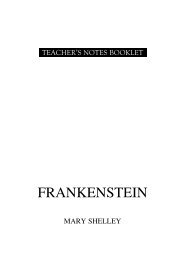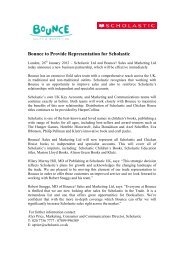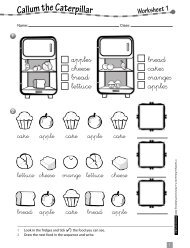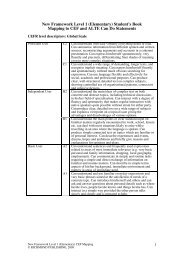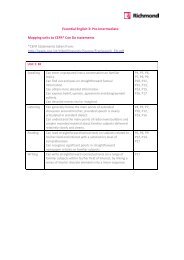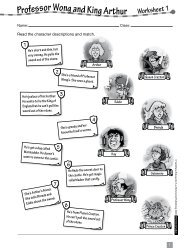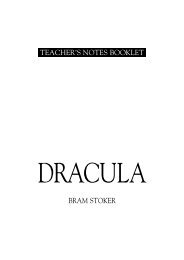New Framework Level 2 (Pre-Intermediate) Student's Book ... - Supadu
New Framework Level 2 (Pre-Intermediate) Student's Book ... - Supadu
New Framework Level 2 (Pre-Intermediate) Student's Book ... - Supadu
You also want an ePaper? Increase the reach of your titles
YUMPU automatically turns print PDFs into web optimized ePapers that Google loves.
<strong>New</strong> <strong>Framework</strong> <strong>Level</strong> 2 (<strong>Pre</strong>-<strong>Intermediate</strong>) Student’s <strong>Book</strong><br />
Mapping to CEF and ALTE Can Do Statements<br />
CEFR level descriptors: Global Scale<br />
Proficient User<br />
Independent User<br />
Basic User<br />
C2<br />
C1<br />
B2<br />
B1<br />
A2<br />
A1<br />
Can understand with ease virtually everything heard or read.<br />
Can summarise information from different spoken and written<br />
sources, reconstructing arguments and accounts in a coherent<br />
presentation. Can express him/herself spontaneously, very<br />
fluently and precisely, differentiating finer shades of meaning<br />
even in more complex situations.<br />
Can understand a wide range of demanding, longer texts, and<br />
recognise implicit meaning. Can express him/herself fluently<br />
and spontaneously without much obvious searching for<br />
expression. Can use language flexibly and effectively for<br />
social, academic and professional purposes. Can produce<br />
clear, well-structured, detailed text on complex subjects,<br />
showing controlled use of organisational patterns, connectors<br />
and cohesive devices.<br />
Can understand the main ideas of complex text on both<br />
concrete and abstract topics, including technical discussions<br />
in his/her field of specialisation. Can interact with a degree of<br />
fluency and spontaneity that makes regular interaction with<br />
native speakers quite possible without strain for either party.<br />
Can produce clear, detailed text on a wide range of subjects<br />
and explain a viewpoint on a topical issue giving the<br />
advantages and disadvantages of various options.<br />
Can understand the main points of clear standard input on<br />
familiar matters regularly encountered in work, school, leisure<br />
etc. can deal with most situations likely to arise whilst<br />
travelling in an area where the language is spoken. Can<br />
produce simple connected text on topics which are familiar or<br />
of personal interest. Can describe experiences and events,<br />
dreams, hopes and ambitions and briefly give reasons and<br />
explanations for opinions and plans.<br />
Can understand sentences and frequently used expressions<br />
related to areas of most immediate relevance (e.g. very basic<br />
personal and family information, shopping, local geography,<br />
employment). Can communicate in simple and routine tasks<br />
requiring a simple and direct exchange of information on<br />
familiar and routine matters. Can describe in simple terms<br />
aspects of his/her background, immediate environment and<br />
matters in areas of immediate need.<br />
Can understand and use familiar everyday expressions and<br />
vary basic phrases aimed at the satisfaction of needs of a<br />
concrete type. Can introduce him/herself and others and can<br />
ask and answer questions about personal details such as where<br />
he/she lives, people he/she knows and things he/she has. Can<br />
interact in a simple way provided the other person talks<br />
slowly and clearly and is prepared to help.<br />
<strong>New</strong> <strong>Framework</strong> <strong>Level</strong> 2 (<strong>Pre</strong>-<strong>Intermediate</strong>) CEF Mapping<br />
© RICHMOND PUBLISHING, 2008<br />
1
Unit 1: The concrete jungle<br />
A2<br />
Speaking Can communicate in simple and routine tasks requiring a<br />
simple and direct exchange of information.<br />
Can describe people, places and possessions in simple<br />
terms.<br />
Listening Can understand and extract the essential information<br />
from short, recorded passages dealing with predictable<br />
everyday matters which are delivered slowly and clearly.<br />
Reading Can understand short, simple texts on familiar matters of<br />
a concrete type which consist of high frequency everyday<br />
or job-related items.<br />
Can identify specific information in simpler written<br />
material he/she encounters such as letters, brochures and<br />
short newspaper articles describing events.<br />
Writing Can write a series of simple phrases and sentences linked<br />
with simple connectors like ‘and’, ‘but’ and ‘because’.<br />
Unit 2: Lives and loves<br />
A2<br />
Speaking Can explain what he/she likes or dislikes about<br />
something.<br />
Can describe plans and arrangements, habits and<br />
routines, past activities and personal experiences.<br />
Listening Can understand and extract the essential information<br />
from short, recorded passages dealing with predictable<br />
everyday matters which are delivered slowly and clearly.<br />
Reading Can understand short, simple texts on familiar matters of<br />
a concrete type which consist of high frequency everyday<br />
or job-related items.<br />
Writing Can write short, simple imaginary biographies and<br />
simple poems about people.<br />
P6 & 7<br />
P12<br />
P11<br />
P10 & 110<br />
P6<br />
P8 & 9<br />
P12<br />
P7<br />
P13<br />
P14 & 15<br />
P16 & 17<br />
P18<br />
P15<br />
P16<br />
P19<br />
P20<br />
P17<br />
P21<br />
<strong>New</strong> <strong>Framework</strong> <strong>Level</strong> 2 (<strong>Pre</strong>-<strong>Intermediate</strong>) CEF Mapping<br />
© RICHMOND PUBLISHING, 2008<br />
2
Unit 3: Work it out<br />
A2<br />
Speaking Can explain what he/she likes or dislikes about<br />
something.<br />
Can participate in short conversations in routine contexts<br />
on topics of interest.<br />
Listening Can understand and extract the essential information<br />
from short, recorded passages dealing with predictable<br />
everyday matters which are delivered slowly and clearly.<br />
Reading<br />
Writing<br />
Can understand short, simple texts on familiar matters of<br />
a concrete type which consist of high frequency everyday<br />
or job-related items.<br />
Can write short, simple imaginary biographies and<br />
simple poems about people.<br />
P22<br />
P24<br />
P26<br />
P23<br />
P25<br />
P27<br />
P29<br />
P24 & 25<br />
P27<br />
P28<br />
P29<br />
World English DVD and Flashback 1<br />
A2<br />
Speaking Can participate in short conversations in routine contexts<br />
on topics of interest.<br />
Listening Can understand and extract the essential information<br />
from short, recorded passages dealing with predictable<br />
everyday matters which are delivered slowly and clearly.<br />
Reading Can understand short, simple texts on familiar matters of<br />
a concrete type which consist of high frequency everyday<br />
or job-related items.<br />
Writing Can write short, simple imaginary biographies and<br />
simple poems about people.<br />
P30 & 31<br />
P32<br />
P30 & 31<br />
P32<br />
P31<br />
P33<br />
P33<br />
<strong>New</strong> <strong>Framework</strong> <strong>Level</strong> 2 (<strong>Pre</strong>-<strong>Intermediate</strong>) CEF Mapping<br />
© RICHMOND PUBLISHING, 2008<br />
3
Unit 4: Sportmania<br />
A2<br />
Speaking Can exchange limited information on familiar and<br />
routine operational matters.<br />
Can participate in short conversations in routine contexts<br />
on topics of interest.<br />
Listening Can understand and extract the essential information<br />
from short, recorded passages dealing with predictable<br />
everyday matters which are delivered slowly and clearly.<br />
Reading Can understand short, simple texts on familiar matters of<br />
a concrete type which consist of high frequency everyday<br />
or job-related items.<br />
Can identify specific information in simpler written<br />
material he/she encounters such as letters, brochures, and<br />
short news paper articles describing events.<br />
Writing Can write a series of simple phrases and sentences linked<br />
with simple connectors like ‘and’, ‘but’ and ‘because’.<br />
Unit 5: In transit<br />
A2<br />
Speaking Can describe people, places and possessions in simple<br />
terms<br />
Can participate in short conversations in routine contexts<br />
on topics of interest.<br />
Listening<br />
Reading<br />
Writing<br />
Can describe plans and arrangements, habits and<br />
routines, past activities and personal experiences.<br />
Can understand and extract the essential information<br />
from short, recorded passages dealing with predictable<br />
everyday matters which are delivered slowly and clearly.<br />
Can understand short, simple texts on familiar matters of<br />
a concrete type which consist of high frequency everyday<br />
or job-related items.<br />
Can write a series of simple phrases and sentences linked<br />
with simple connectors like ‘and’, ‘but’ and ‘because’.<br />
P36<br />
P34<br />
P38<br />
P35<br />
P37<br />
P39<br />
P36<br />
P38 & 39<br />
P40<br />
P41<br />
P43<br />
P42<br />
P44<br />
P46<br />
P45<br />
P43<br />
P45<br />
P46 & 47<br />
P48<br />
P44<br />
P46<br />
P48<br />
<strong>New</strong> <strong>Framework</strong> <strong>Level</strong> 2 (<strong>Pre</strong>-<strong>Intermediate</strong>) CEF Mapping<br />
© RICHMOND PUBLISHING, 2008<br />
4
Unit 6: Food to go<br />
A2<br />
Speaking Can say what he/she likes and dislikes. P52<br />
Can participate in short conversations in routine contexts<br />
on topics of interest.<br />
P50<br />
P51<br />
Can agree and disagree with others.<br />
P55<br />
Listening<br />
Reading<br />
Writing<br />
Can make and respond to suggestions.<br />
Can understand and extract the essential information<br />
from short, recorded passages dealing with predictable<br />
everyday matters which are delivered slowly and clearly.<br />
Can understand short, simple texts on familiar matters of<br />
a concrete type which consist of high frequency everyday<br />
or job-related items.<br />
Can identify specific information in simpler written<br />
material he/she encounters such as letters, brochures and<br />
short newspaper articles describing events.<br />
Can write a series of simple phrases and sentences linked<br />
with simple connectors like ‘and’, ‘but’ and ‘because’.<br />
P55<br />
P51<br />
P53<br />
P56<br />
P50<br />
P54<br />
P52<br />
P56<br />
World English DVD and Flashback 2<br />
A2<br />
Speaking Can participate in short conversations in routine contexts<br />
on topics of interest.<br />
Listening Can understand and extract the essential information<br />
from short, recorded passages dealing with predictable<br />
everyday matters which are delivered slowly and clearly.<br />
Reading Can understand short, simple texts on familiar matters of<br />
a concrete type which consist of high frequency everyday<br />
or job-related items.<br />
Writing Can write a series of simple phrases and sentences linked<br />
with simple connectors like ‘and’, ‘but’ and ‘because’.<br />
P58 & 59<br />
P58 & 59<br />
P60<br />
P61<br />
<strong>New</strong> <strong>Framework</strong> <strong>Level</strong> 2 (<strong>Pre</strong>-<strong>Intermediate</strong>) CEF Mapping<br />
© RICHMOND PUBLISHING, 2008<br />
5
Unit 7: Money talks<br />
A2<br />
Speaking Can participate in short conversations in routine contexts<br />
on topics of interest.<br />
Can agree and disagree with others.<br />
Can give a simple description or presentation of people,<br />
living or working conditions, daily routines,<br />
likes/dislikes etc. as a short series of simple phrases and<br />
sentences liked into a list.<br />
Listening Can understand and extract the essential information<br />
from short, recorded passages dealing with predictable<br />
everyday matters which are delivered slowly and clearly.<br />
Reading Can understand short, simple texts on familiar matters of<br />
a concrete type which consist of high frequency everyday<br />
or job-related items.<br />
Can identify specific information in simpler written<br />
material he/she encounters such as letters, brochures and<br />
short newspaper articles describing events.<br />
Writing Can write a series of simple phrases and sentences linked<br />
with simple connectors like ‘and’, ‘but’ and ‘because’.<br />
P64<br />
P66<br />
P68<br />
P63<br />
P67<br />
P68<br />
P63<br />
P64<br />
P69<br />
Unit 8: Gossip<br />
A2<br />
Speaking Can participate in short conversations in routine contexts<br />
on topics of interest.<br />
Can agree and disagree with others.<br />
Can agree and disagree with others.<br />
Listening Can understand and extract the essential information<br />
from short, recorded passages dealing with predictable<br />
everyday matters which are delivered slowly and clearly.<br />
Reading Can understand short, simple texts on familiar matters of<br />
a concrete type which consist of high frequency everyday<br />
Writing<br />
or job-related items.<br />
Can identify specific information in simpler written<br />
material he/she encounters such as letters, brochures and<br />
short newspaper articles describing events.<br />
Can write a series of simple phrases and sentences linked<br />
with simple connectors like ‘and’, ‘but’ and ‘because’.<br />
P70<br />
P72<br />
P76<br />
P73<br />
P70<br />
P73<br />
P77<br />
P74<br />
P71 & 122<br />
P75<br />
P76<br />
P75<br />
<strong>New</strong> <strong>Framework</strong> <strong>Level</strong> 2 (<strong>Pre</strong>-<strong>Intermediate</strong>) CEF Mapping<br />
© RICHMOND PUBLISHING, 2008<br />
6
Unit 9: Hi-tech<br />
A2<br />
Speaking Can participate in short conversations in routine contexts<br />
on topics of interest.<br />
Can agree and disagree with others.<br />
Can describe plans and arrangements, habits and<br />
routines, past activities and personal experiences.<br />
Listening Can understand and extract the essential information<br />
from short, recorded passages dealing with predictable<br />
everyday matters which are delivered slowly and clearly.<br />
Reading Can understand short, simple texts on familiar matters of<br />
a concrete type which consist of high frequency everyday<br />
or job-related items.<br />
Writing Can write a series of simple phrases and sentences linked<br />
with simple connectors like ‘and’, ‘but’ and ‘because’.<br />
P78 & 79<br />
P82<br />
P80<br />
P84<br />
P78<br />
P82 & 83<br />
P80<br />
P83<br />
P84<br />
World English DVD and Flashback 3<br />
A2<br />
Speaking Can participate in short conversations in routine contexts<br />
on topics of interest.<br />
Listening Can understand and extract the essential information<br />
from short, recorded passages dealing with predictable<br />
everyday matters which are delivered slowly and clearly.<br />
Writing Can write a series of simple phrases and sentences linked<br />
with simple connectors like ‘and’, ‘but’ and ‘because’.<br />
P86<br />
P86 & 87<br />
P88<br />
P88<br />
<strong>New</strong> <strong>Framework</strong> <strong>Level</strong> 2 (<strong>Pre</strong>-<strong>Intermediate</strong>) CEF Mapping<br />
© RICHMOND PUBLISHING, 2008<br />
7
Unit 10: Global Chat<br />
A2<br />
Speaking Can participate in short conversations in routine contexts<br />
on topics of interest.<br />
Can agree and disagree with others.<br />
Listening<br />
Reading<br />
Writing<br />
Can understand and extract the essential information<br />
from short, recorded passages dealing with predictable<br />
everyday matters which are delivered slowly and clearly.<br />
Can understand short, simple texts on familiar matters of<br />
a concrete type which consist of high frequency everyday<br />
or job-related items.<br />
Can identify specific information in simpler written<br />
material he/she encounters such as letters, brochures and<br />
short newspaper articles describing events.<br />
Can write a series of simple phrases and sentences linked<br />
with simple connectors like ‘and’, ‘but’ and ‘because’.<br />
Unit 11: Secret styles<br />
A2<br />
Speaking Can participate in short conversations in routine contexts<br />
on topics of interest.<br />
Can agree and disagree with others.<br />
Can give a simple description or presentation of people,<br />
living or working conditions, daily routines,<br />
likes/dislikes etc. as a short series of simple phrases and<br />
sentences linked into a list.<br />
Listening Can understand and extract the essential information<br />
from short, recorded passages dealing with predictable<br />
everyday matters which are delivered slowly and clearly.<br />
Reading<br />
Writing<br />
Can understand short, simple texts on familiar matters of<br />
a concrete type which consist of high frequency everyday<br />
or job-related items.<br />
Can identify specific information in simpler written<br />
material he/she encounters such as letters, brochures and<br />
short newspaper articles describing events.<br />
Can write a series of simple phrases and sentences linked<br />
with simple connectors like ‘and’, ‘but’ and ‘because’.<br />
P90<br />
P92<br />
P93<br />
P96<br />
P90 & 91<br />
P92<br />
P94<br />
P94<br />
P97<br />
P93<br />
P96<br />
P95<br />
P103<br />
P99<br />
P104<br />
P98<br />
P101<br />
P103<br />
P104<br />
P103<br />
P101<br />
<strong>New</strong> <strong>Framework</strong> <strong>Level</strong> 2 (<strong>Pre</strong>-<strong>Intermediate</strong>) CEF Mapping<br />
© RICHMOND PUBLISHING, 2008<br />
8
Unit 12: Alternatives<br />
A2<br />
Speaking Can participate in short conversations in routine contexts<br />
on topics of interest.<br />
Can agree and disagree with others.<br />
Can give a short, rehearsed basic presentation on a<br />
familiar subject.<br />
Can give a simple description or presentation of people,<br />
living or working conditions, daily routines,<br />
likes/dislikes etc. as a short series of simple phrases and<br />
sentences linked into a list.<br />
Can explain what he/she likes or dislikes about<br />
something.<br />
Listening Can understand and extract the essential information<br />
from short, recorded passages dealing with predictable<br />
everyday matters which are delivered slowly and clearly.<br />
Reading<br />
Writing<br />
Can understand short, simple texts on familiar matters of<br />
a concrete type which consist of high frequency everyday<br />
or job-related items.<br />
Can identify specific information in simpler written<br />
material he/she encounters such as letters, brochures and<br />
short newspaper articles describing events.<br />
Can write a series of simple phrases and sentences linked<br />
with simple connectors like ‘and’, ‘but’ and ‘because’.<br />
World English DVD and Flashback 4<br />
A2<br />
Speaking Can participate in short conversations in routine contexts<br />
on topics of interest.<br />
Listening Can understand and extract the essential information<br />
from short, recorded passages dealing with predictable<br />
everyday matters which are delivered slowly and clearly.<br />
Writing Can write a series of simple phrases and sentences linked<br />
with simple connectors like ‘and’, ‘but’ and ‘because’.<br />
P107<br />
P110<br />
P109<br />
P112<br />
P106<br />
P109<br />
P111<br />
P112<br />
P107<br />
P108<br />
P110<br />
P112 & 113<br />
P111<br />
P114<br />
P116<br />
P114<br />
P117<br />
P116<br />
<strong>New</strong> <strong>Framework</strong> <strong>Level</strong> 2 (<strong>Pre</strong>-<strong>Intermediate</strong>) CEF Mapping<br />
© RICHMOND PUBLISHING, 2008<br />
9



